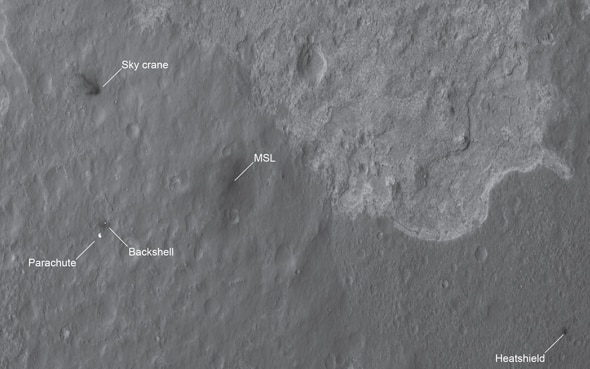Create a free profile to get unlimited access to exclusive videos, sweepstakes, and more!
Like Tears in Rain: Our Scars on Mars Fade

When the Curiosity rover landed on Mars, it wasn’t alone. On its way in it also dropped its heat shield, its backshell and parachute, and the rocket-powered sky crane.
That last piece of hardware was pretty much what it sounds like: A platform that used rockets to hover over the surface of Mars, lowered the rover down, then blasted away to a safe distance once Curiosity was firmly down. The sky crane rose in a parabolic arc, then impacted the ground, hard, about 650 meters away. It was still moving horizontally, so it left a blast pattern on the surface, blowing the dust away off the ground. The dust is brighter than the rock beneath, so it left behind a dark splash pattern.
That was about 2½ years ago, and Mars hasn’t sat still. Weather and winds have beaten at the marks left by Curiosity’s accoutrements, and they’ve faded with time. JPL just released this amazing animation composed of images taken by the HiRISE camera on Mars Reconnaissance Orbiter, showing the erosion of the marks over time:
Photo by NASA/JPL-Caltech/University of Arizona
As you can see, the marks have faded, most likely gradually being covered over by dust. The other pieces of hardware show similar changes (though less dramatic, given their smaller impacts)—you can watch the animations for the heat shield, the backshell and parachute, and the rover landing site itself (of course, Curiosity has long since left; it’s a rover).
It’s not as simple as fading, though; the marks from the sky crane have also recently darkened. It’s not clear why, though it’s possible dust blew in, then blew out again. We’ve seen the dust on Mars has done more elaborate and weirder things.
This is more than just interesting: We’re gearing up to send more probes to Mars, and eventually people. Understand the Martian weather will be critical. The dust is extremely fine, like talcum powder, and made of iron oxide: rust. It will get into everything (it coated Opportunity’s solar panels, reducing power until strong winds cleaned it off later). Understanding the dust transport mechanisms will be crucial for living on Mars as well.
And since you’re here, why not: Back when the landing took place, YouTube user Dominic Muller created an amazing video using images taken from the descent camera on the sky crane; he used a technique called interpolation to smooth out the video, and if you haven’t seen it (or it’s been a couple of years), watch it! It’s quite remarkable.


























